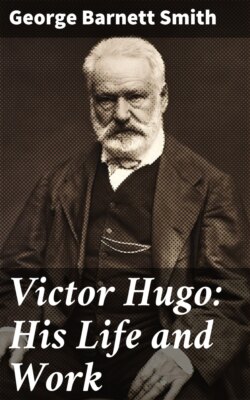Читать книгу Victor Hugo: His Life and Work - George Barnett Smith - Страница 5
CHAPTER III. VICTOR HUGO'S HUMANITARIANISM.
ОглавлениеIn 1829 Victor Hugo published anonymously his Le Dernier Jour d'un Condamné ('The Last Day of a Convict'). It thrilled the heart of Paris by its vivid recitals. While having no pretensions to the character of a regular tale, it was, as a writer in the Edinburgh Review remarked, one of the most perfect things the author had as yet produced. It was the representation of one peculiar state of mind—that of a criminal faced by the certainty of his approaching death under the guillotine. Like Sterne, Hugo had taken a single captive, shut him up in his dungeon, and 'then looked through the twilight of the grated door, to take his picture.' The work is a chronicle of thoughts, a register of sensations; and it is amazing to see what variety and dramatic movement may be imparted to a monologue in which the scene shifts only from, the Bicètre to the Conciergerie, the Hôtel de Ville, and the Place de Grève.
Few descriptions could be found in literature to vie with that in which Victor Hugo places the criminal before us as he enters the court to receive his sentence on a lovely August morning. But all the incidents attending the trial, the condemnation, and the execution are depicted with graphic skill and powerful energy. No one knows better than Victor Hugo how to relieve unutterable gloom by some brilliant ray of human affection, and so upon this condemned prisoner he causes to break a temporary vision of youth and innocence. The intensity all through this piece is such as to give the reader a strange realization of the criminal, with his weight of guilt, and his terrible and conflicting emotions.
But the critic of the Edinburgh would have us believe that all this was merely due to a desire by Victor Hugo to exhibit his literary skill. He even calls it absurd to regard the sketch as a pleading against the punishment of death, and roundly denies that the author had any such esoteric purpose. Unfortunately for him, there is conclusive evidence to prove that Victor Hugo had a deeper intent in this painful representation than a mere literary play upon the feelings. In a preface to the edition of 1832 he distinctly avows his purpose: 'It is the author's aim and design that posterity should recognise in his work not a mere special pleading for any one particular criminal, which is always easy and always transitory, but a general and permanent appeal in behalf of all the accused, alike of the present and of the future. Its great point is the right of humanity urged upon society.'
Moreover, there is another powerful argument to be considered. Ever since 1820 Victor Hugo had been deeply moved on the question of capital punishment, and resolved to labour for its abolition. It will be convenient here to review briefly his public utterances on the subject, both before and subsequent to the appearance of Le Dernier Jour d'un Condamné. We shall thereby be enabled to keep the literary and personal thread of our narrative intact. In the year above named Victor Hugo had seen Louvel, the murderer of the Duke of Berry, on his way to the scaffold. The culprit was a being for whom he had not the slightest sympathy; but his fate begat pity, and he began to reflect on the anomaly that society should, in cold blood, commit the same act as that which it punished. From that time, observes Madame Hugo, he had an idea of writing a book against the guillotine. Two executions which he witnessed during the next few years strengthened his convictions, and led to the work we have already discussed. Subsequently he wrote Claude Gueux, founded upon the sad and miserable story of a man of that name. Gueux was condemned to death in 1832 for a crime to which the pangs of hunger had impelled him. The case was doubly painful from the fact that the father of Claude, a very old man, had been sentenced to a punishment in the prison of Clairvaux, and the son, in order to bring help to him, committed an act whose consequences brought him within the walls of the same prison. Strenuous exertions were made by Hugo and others to save Gueux, but the Council of Ministers rejected the appeal. The man was executed, and a noble protest which Victor Hugo afterwards issued greatly moved the public conscience, and rendered society still more familiar with the writer's views.
In May, 1839, one Barbès was condemned to death for his share in the insurrection in the Place Royale. Victor Hugo immediately sent this message of appeal to the King:
